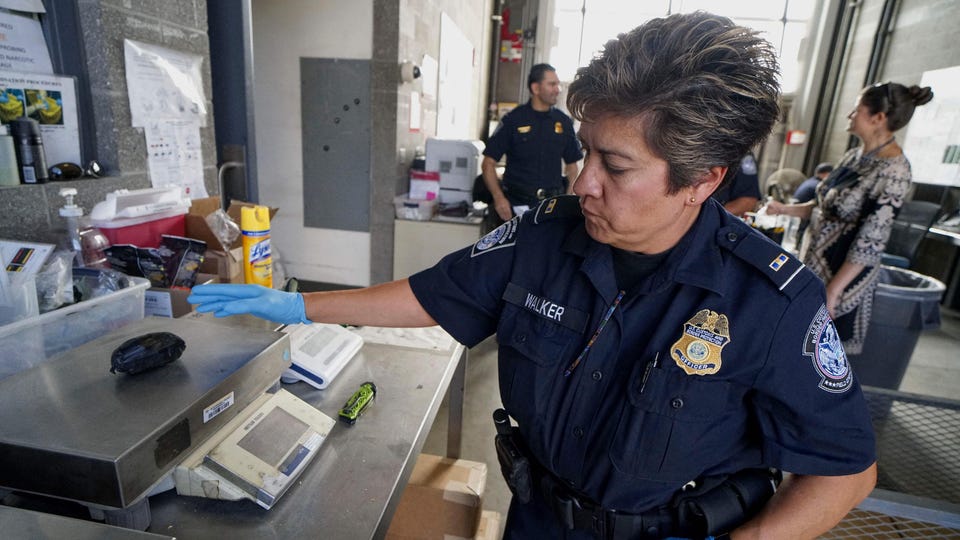Synthetic Opioid Overdose Deaths Soared While Trump Was President


Overdose deaths from synthetic opioids soared during the time Donald Trump was president, raising questions about efforts to blame the Biden administration’s border policies for drug overdose deaths. Data show the Trump administration’s decision to close U.S. ports of entry to nonessential traffic during the Covid-19 pandemic in March 2020 had the consequence of accelerating drug traffickers’ shift to fentanyl, a more potent drug than heroin, which helped lead to an increase in drug overdose deaths.
Between 2016 and 2020, annual drug overdose deaths from synthetic opioids (excluding methadone) increased by 192% (from 19,500 to 56,894), according to the Centers for Disease Control and Prevention (CDC). The CDC data also show:
– The average annual growth rate of drug overdose deaths from synthetic opioids was 31% while Donald Trump was president.
– Between 2019 and 2020, the last year of Trump’s presidency, the increase in drug overdose deaths from synthetic opioids was 55%.
– Between 2020 and 2021, the first year of Joe Biden’s presidency, the increase in drug overdose deaths from synthetic opioids was 25%.
Because fentanyl is so potent in small quantities, it is dangerous for users but profitable for drug traffickers. The Trump administration’s decision to shut down all but nonessential traffic at U.S.-Mexico ports of entry on March 20, 2020, appears to have spurred traffickers to shift from heroin to fentanyl.
“Despite fentanyl’s built‐in economic advantage, it took the massive restriction in imports and travel during the pandemic—particularly the U.S. policy of limiting travel with Mexico—to force U.S.-Mexico border traffickers to shift from heroin to fentanyl,” testified David Bier of the Cato Institute during a House Homeland Security Committee hearing (February 28, 2023). “Within two months of the pandemic, fentanyl seizures overtook heroin by weight, and by the time the restrictions were lifted, fentanyl was accounting for over 90 percent of the seizures.” (The weight of fentanyl seized by U.S. Customs and Border Protection increased ten-fold between December 2019 and December 2020.)
CDC data show unusually large increases in the 12-month moving average of drug overdose deaths from synthetic opioids in April, May, June, July and August 2020, which continued through the remainder of the calendar year, based on a National Foundation for American Policy analysis. Precise month-by-month figures are unavailable from the CDC, but even the 12-month moving averages, which likely mask much larger increases in individual months, show a significant rise after the March 2020 closing of U.S.-Mexico ports of entry to nonessential traffic.
Some Republicans on the House Homeland Security Committee criticized Bier for his testimony as it ran counter to the hearing’s title, “Every State Is a Border State: Examining Secretary Mayorkas’ Border Crisis.” Bier explained that asylum seekers are the least likely people to carry fentanyl across the U.S.-Mexico border since they immediately turn themselves in to Border Patrol Agents or ask for asylum, when permitted, at ports of entry. A more orderly process for people seeking protection would free up law enforcement resources. (Bier was not given a chance to respond to several assertions by Republican members and published additional responses after the hearing.)
Democratic committee members pointed out through questioning that the vast majority (93%) of fentanyl is seized at ports of entry or checkpoints—not between ports of entry by Border Patrol agents. Moreover, Democratic members noted those convicted for smuggling fentanyl are primarily U.S. citizens (86%).
Democrats at the hearing did not point out that synthetic opioid deaths increased significantly while Donald Trump was president. This was surprising since even Republican Homeland Security Committee Chairman Mark E. Green (R-TN) noted in his opening statement that the two sons of the mother who testified at the hearing died of “fentanyl poisoning in 2020.”
While blaming immigrants for the fentanyl crisis may have political appeal, research by professors Ben Feldmeyer (Univ. of Cincinnati), Diana Sun (Florida Atlantic University), Casey T. Harris (Univ. of Arkansas) and Francis T. Cullen (Univ. of Cincinnati) found immigrants are associated with fewer drug overdoses and homicides in an area.
“Our findings directly contradict the pervasive fears and political rhetoric suggesting that immigration has fueled drug problems across U.S. communities,” according to the authors, who analyzed data from 2000 to 2015. “We see no evidence linking immigration to rising overdose death rates, and instead we find that immigration has most often been associated with lower levels of overdoses and homicide mortality. Thus, it appears that, if anything, immigration is more likely to have been part of the solution than the source of the overdose crisis of the early twenty-first century.”
Feldmeyer, Sun, Harris and Cullen found, “County overdose rates were reduced by 4.5% for every one-percentage-point increase in the foreign-born population. . . . Taken together, these supplemental models show sizable protective effects of immigration and suggest that a 10-percentage-point increase in a county’s foreign-born population could contribute to as much as 40% to 50% lower overdose death rates overall and for nearly each of the substances examined here, net of controls.”
The evidence indicates that closing the door to immigration will not reduce deaths from drug overdoses. The data show that stopping most traffic at U.S.-Mexico ports of entry in 2020 while Donald Trump was president had the unintended consequence of encouraging drug traffickers to switch from heroin to fentanyl, which contributed to an increase in synthetic opioid-related deaths in America.
